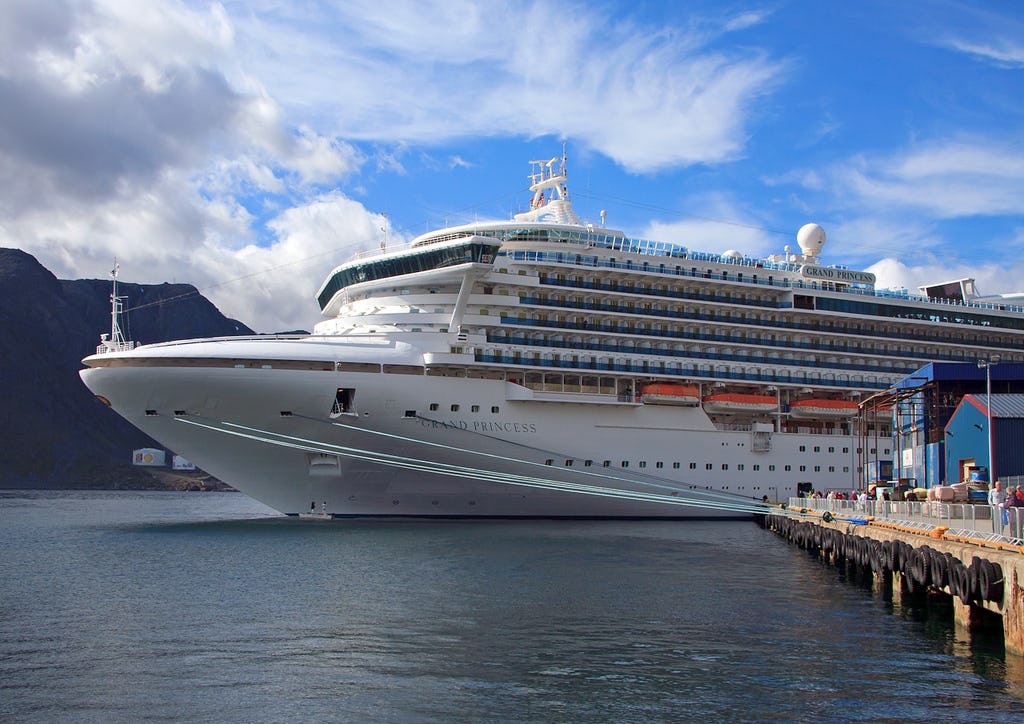Cruise Tourism in the Arctic: Recipe for Disaster?

The cruise liner Grand Princess at Honningsvåg, Norway. Photo: John6536 (Flickr)
The sinking of the cruise ship Costa Concordia off the coast of Italy has both cruise industry specialists as well as the general public scrutinizing the safety of this form of travel, and contemplating the gravity of the unforeseen environmental consequences of an accident. The catastrophe was certainly keenly sensed even at the furthest ends of the globe – there is perhaps nowhere else on earth where the image of a ship’s crisis situation hits so close to home as the icy, remote, and often unnavigable waters within the polar regions.
Indeed, the nightmare scenario of a comparable disaster occurring in the North is not far from reality. There have already been several notable accidents in the Arctic:
The luxury liner Prinsendam, built in 1973, was transiting through Gulf of Alaska waters in 1980 when a fire broke out in the engine room. Eventually, the fire became out of control, and the vessel’s master sent a distress call for immediate assistance and ordered an evacuation. Fortuitously, the supertanker Williamsburgh as well as the United States Coast Guard Cutter Mellon were nearby to assist with the rescue, along with Coast Guard aircraft. In the end there were no serious injuries and all passengers and crew were brought to safety, although one full lifeboat was missing for some 18 hours.
More recently, in 2010, the MV Clipper Adventurer ran aground of a rock in Coronation Gulf, Nunavut in the Canadian Arctic during a cruise. While the ship’s operator originally claimed they had hit an uncharted rock, it was later determined that the hazard was already reported and documented by the Canadian Hydrographic Service. All passengers and crew were brought to safety.
Also in 2010, the cruise ship Clelia II evacuated all 100 passengers and crew after a strong current pushed it toward a rocky shoreline, disabling the vessel. Again, with luck, there was another ship nearby to provide assistance.
While these accidents all had miraculously effective rescues, the case may not always be so. Tourism in the Arctic is heavily on the rise, in large part because of the effects of global climate change that make formerly remote areas accessible to cruise vessels. Ironically, as a 2007 article in Arctic pointed out, the warming climate may lead to a false sense of optimism about the ease of tourism in Arctic waters, which in fact may become more dangerous to navigate as the character and distribution of ice change. Not to mention, The Explorer, Clipper, and Clelia II were all ice-capable ships – which is not true of all cruise vessels that now venture into Polar waters for tours.
The potential for cruise ship disasters in the Polar Regions is a serious concern not only for cruise operators interested in the safety of their passengers and crew, but also has broader implications for environmental safety. There is fear about the damaging pollution resulting from a potential accident should it cause fuel to leak from a ship or, worse, for a ship to submerge entirely in Polar waters. There is also the baseline concern about the environmental effects of increased ship traffic even without incident.
All of that being said, it is unreasonable to ONLY focus on the worse case scenario aspects of Cruise tourism, as did a recent article in Popular Mechanics. Yes, at worst cruise tourism in the Arctic can mean serious safety and security risks and potential environmental degradation. However, the vast majority of the time cruise tourism in the Arctic means a thrilling experience for passengers, an appreciation for the Arctic region, and a boon for the economy of remote areas.
I suggest that when considering cruise tourism in the Arctic we need to look objectively at the whole picture. It’s easy to descend into alarmist rhetoric about the dangers of passenger vessels that operate in the Arctic, particularly in the shadow of a tragedy like that of the Costa Concordia. In spite of that, the facts tell a different story – despite accidents, there have been no deaths related to cruise tourism in the Arctic.
Furthermore, the capability to deal with a disaster involving a ship in the Arctic is of such recognized importance that it is the first issue-area in which cooperation through Arctic Council has produced binding law. At the Arctic Council ministerial meeting in Nuuk in May 2011, the “Aeronautical and Maritime Search and Rescue in the Arctic” treaty became the first international agreement written exclusively for the Arctic region.
While there certainly is a need to remain attentive to the very serious potential dangers associated with cruise tourism in the Arctic, theorizing about catastrophe should not scare us away from recognizing an industry that could be a boon to the region. In all likelihood, we will see far more benefits from cruise tourism in the Arctic in the next few decades than damaging disasters. Chances are that far more tourists will enjoy an eye-opening and educational experience in the North, while at the same time injecting much-needed capital into remote communities, than will end up shipwrecked.